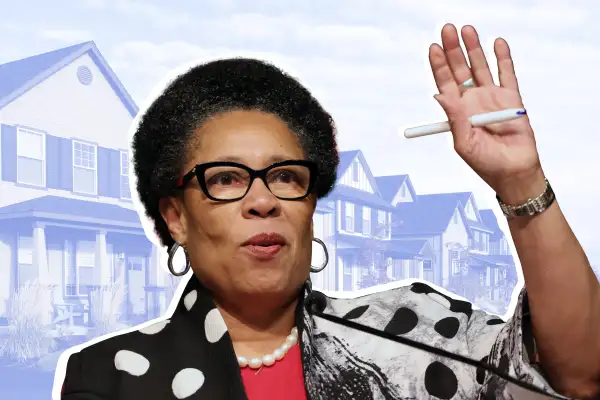This Year May Be 'Tough' for Housing Affordability — But Help Is on the Way: HUD Secretary

Americans are feeling better about the housing market right now than they have in years — but that doesn’t mean the nation’s affordability issues are set to drastically improve anytime soon.
“It’s going to be tough, there’s no question about it,” Marcia Fudge, secretary of the Department of Housing and Urban Development (HUD), tells Money.
Already this year, easing mortgage rates have sparked buyer interest and helped produce a small uptick in home sales. But plenty of obstacles remain, especially for first-time and low- to moderate-income homebuyers, which means optimism about housing affordability in 2024 should be taken with a grain of salt.
Fudge’s assessment, for instance, is based on other factors that are making a home purchase difficult. In addition to coping with still-elevated mortgage rates, buyers are facing high home prices and low inventory, meaning they have to pay more for a limited selection.
Despite the challenges, Fudge says she is optimistic that HUD will be able to aid homebuyers by expanding many services already in place. Last year, these programs helped more than 675,000 borrowers obtain loans and buy homes, according to the federal government.
HUD initiatives include counseling to help would-be buyers understand the homebuying process and changing the way borrowers with student debt are evaluated for mortgages. The department has also adjusted how the agency, through its Federal Housing Administration (FHA) lending program, determines a borrower’s creditworthiness: It now takes on-time rental payments into consideration, which ultimately makes it easier to get a home loan.
Fudge says she is also excited about the possibility of growing the department's down payment assistance programs, for which President Joe Biden has requested $100 million in funding in his current budget. In 2023, almost 230,000 FHA borrowers were able to obtain a mortgage thanks to federal down payment assistance; if approved, Fudge says Biden’s funding could help reach an even larger number of borrowers.
While making financing more accessible is a major HUD objective, there are other issues the agency is working on to help improve affordability.
Why inventory remains a challenge for the housing market
Aside from mortgage rates, one of the main barriers homebuyers face is a major lack of affordable homes for sale. Following the housing crash of 2008, fewer homes were built, causing inventory to fall behind the rate of household formation even after the market recovered.
According to Fudge, the U.S. is about 3 million homes short of a healthy supply of affordable housing, making it difficult for lower-income families to get into homeownership. There’s just too much competition for available homes, which has pushed home prices out of reach for many.
“Over the last decade or so, we’ve spent very little resources fielding affordable housing,” Fudge says, referring to the lack of incentives for builders to create less-expensive homes.
She says she believes the answer lies in alternative housing options like modular homes, accessory dwelling units (ADUs) and manufactured homes, among others. HUD initiatives like the Community Development Block Grant, which provides local governments with funding to develop affordable housing, are a major part of the Biden administration’s efforts to increase the affordable housing supply.
Other options for more affordable housing include the development of tiny home communities, which have been used in cities like Austin, Texas, as a means of combating homelessness. (More recently, tiny home villages have grown in popularity.) Alternatives to waiting for new homes to be built also include converting empty commercial buildings into residences and revamping some of the estimated 15 million vacant homes in the U.S.
Working with local governments to change zoning laws, which often ban the construction of condos and ADUs in suburban areas, are another piece in solving the inventory puzzle: Local housing restrictions can increase the cost of a home by nearly 30%, Fudge adds.
“We cannot get out of this by just building new,” she says. “We just have to get communities to start looking at things differently.”
The inventory shortfall means that home prices are likely to increase across most markets in the U.S. as buyer demand continues to outpace the number of homes for sale. According to the National Association of Realtors, the median home price is forecast to jump by about 1% this year, with certain markets seeing more significant price growth.
Adding more supply to the market may help stabilize the cost of buying a home. The caveat? Although some cities may see home prices decline this year, they won’t go down in general until new listings increase.
Despite the difficulties facing buyers in the 2024 housing market, Fudge remains hopeful about finding solutions soon because the affordability crunch has helped bring attention to the issue.
“Finally, everyone in this country now realizes that affordable housing, or the lack thereof, is in crisis,” she says. “Once people focus on it and make it a priority, they tend to do more work around it.”

